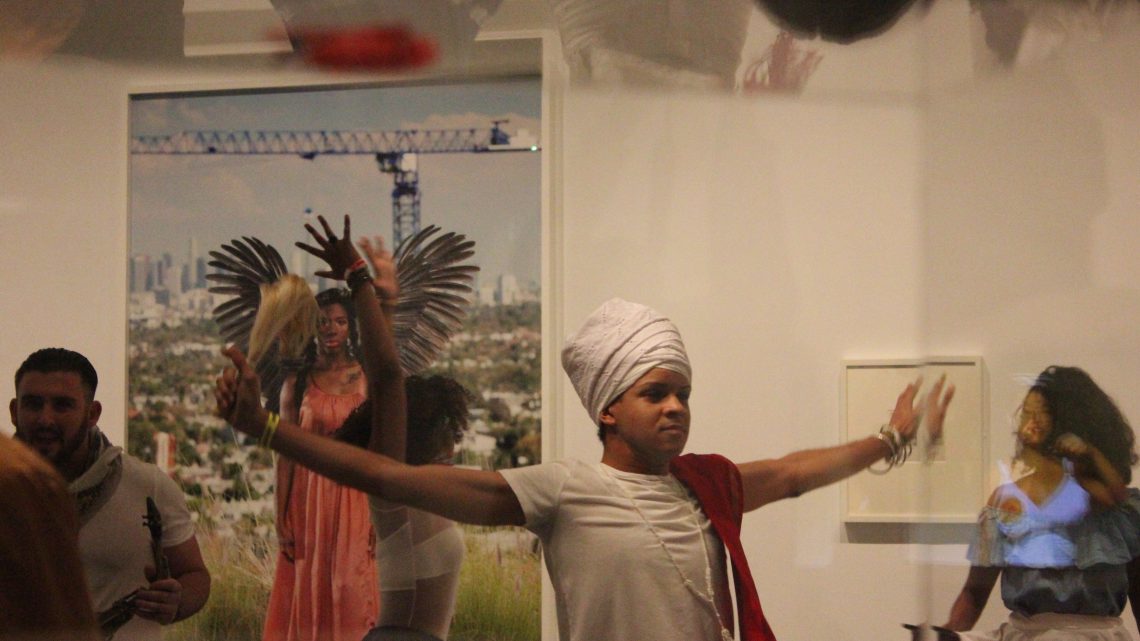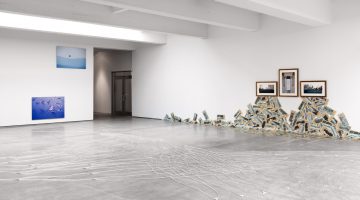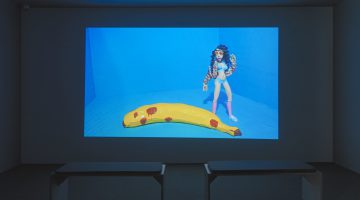The affect of the museum at midnight I can only describe as giddy. This was my main observation of the Museum of Fine Arts Boston’s new public programming initiative, #mfaNOW Overnight, in which the museum remained open all night and dropped admission charges each month this past fall. It seemed like too experimental an idea for the Puritan north. I wondered if it was influenced by a recent acquisition, Christian Marclay’s The Clock, a 24-hour montage of clips showing clock faces taken from popular movies which functions as a real clock, part of the work’s ownership guidelines requires museums to be open 24 hours several times so it can be viewed in full. In the spirit of an artwork which never sleeps, I thought I may as well stay the whole night, from 9AM on a Friday to 9AM Saturday, to take notes on the life of a museum after dark. I would be like Francis Alÿs’s fox set loose in the National Portrait Gallery, scurrying around the pictures while everyone else is turning in for the night.
–
December 9 – 10, 2016
9:03pm
I realize that the number one perk of arts writing is being able to cut the forty minute line of people stuck waiting outside in the Boston winter.
9:10pm
I make it past the coat check, where another line is forming, to TRUST (the presence of secrets), a project by Harvard’s MetaLAB installed on the first and second floor of the museum. One of various local projects invited especially for the event, it allows participants to type a secret into the monitor (which displays encoded, in case anyone is looking over their shoulder). This then prints on receipt paper in an apparently randomized order beside the monitor and on the floor above. “Maybe blue isn’t my favorite color,“ I write. The machine, which is psychic and can tell that I haven’t been particularly vulnerable with it, prints out, “John Mayer is my favorite part of the year.”
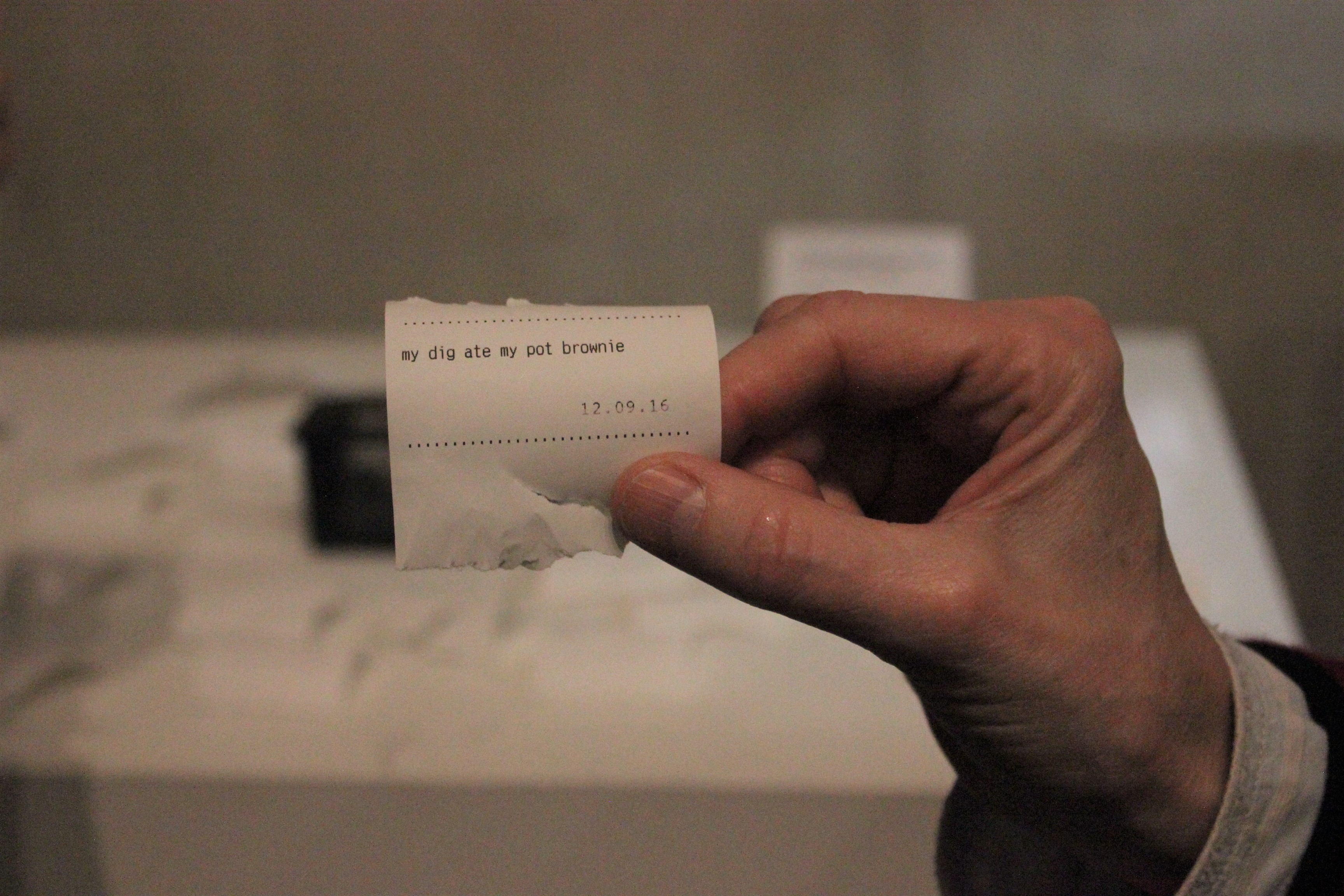
Visitor holding a recent printout reading ‘my dig ate my pot brownie’ from ‘Trust (the presence of secrets),’ by Sarah Newman & Jessica Yurkofsky from Harvard’s MetaLab.
9:14pm
I look up from my receipt to see someone dressed as an elf with what looks like a light-up vacuum cleaner strapped to his back surrounded by women taking cellphone photos. Then everyone suddenly disperses. This bodes well for the evening.
9:21pm
Sidetracked by Patty Chang’s Melons (At a Loss), a video piece in which the artist seems to be cutting off her own breast and eating it with a spoon as she speaks facing the camera. It’s a cantaloupe concealed in her bra, but the effect of this simplest of stage props is unsettling. (Guard: “It actually makes you kind of hungry.” )
9:38pm
I wander into a short talk by a curator on Carmen Herrera’s Blanco y Verde (#1), a big white canvas whose only action is two lateral zippy green triangles that imply a disappearing point, both flattening and deepening the pictorial space of the canvas at the same time. The curator addresses the audience with the veiled desperation of a street magician: at any minute, the on-lookers, idling and loosely circled, could wander off; at any minute, the curator could lose the dollars in their hat. My deepest sympathies, gesticulating curator. It’s hard to get people to look hard at a painting in an era of proliferating screens.
9:43pm
Loitering in Frances Stark’s Bobby Jesus’s Alma Mater b/w Reading the Book of David and/or Paying Attention is Free (2013), a video projection against canonical images from art history and photos of the artist’s studio assistant/ muse Bobby Jesus arranged along the black and white squares of a checkerboard. The club beat of its soundtrack is not wasted upon a group of tipsy young ladies, each dancing with a beer in the left hand and a phone in the right. They alternate dancing, texting, and reading aloud the subtitles: “U don’t need no money, u don’t need no clothes…”
10:20pm
I stop by a project from a student at the MIT Media Lab about the future of policing. Laid out on a table are various objects, all of which look totally mass-produced and functional, meant to suggest things the police might use a decade or two down the road: an object like a cross between a taser and a phone charger, red lights blinking on the end, a syringe and other objects in a black medical briefcase. Participants can choose an object and predict a circumstance in which the object is deployed on a response sheet. Sample response to the medical device: “Cops in Boston & perhaps other cities would use syringes to provide electrolyte shots to marathon runners for oral hydration, further use could be hydration shots for elders during hot summer months.”
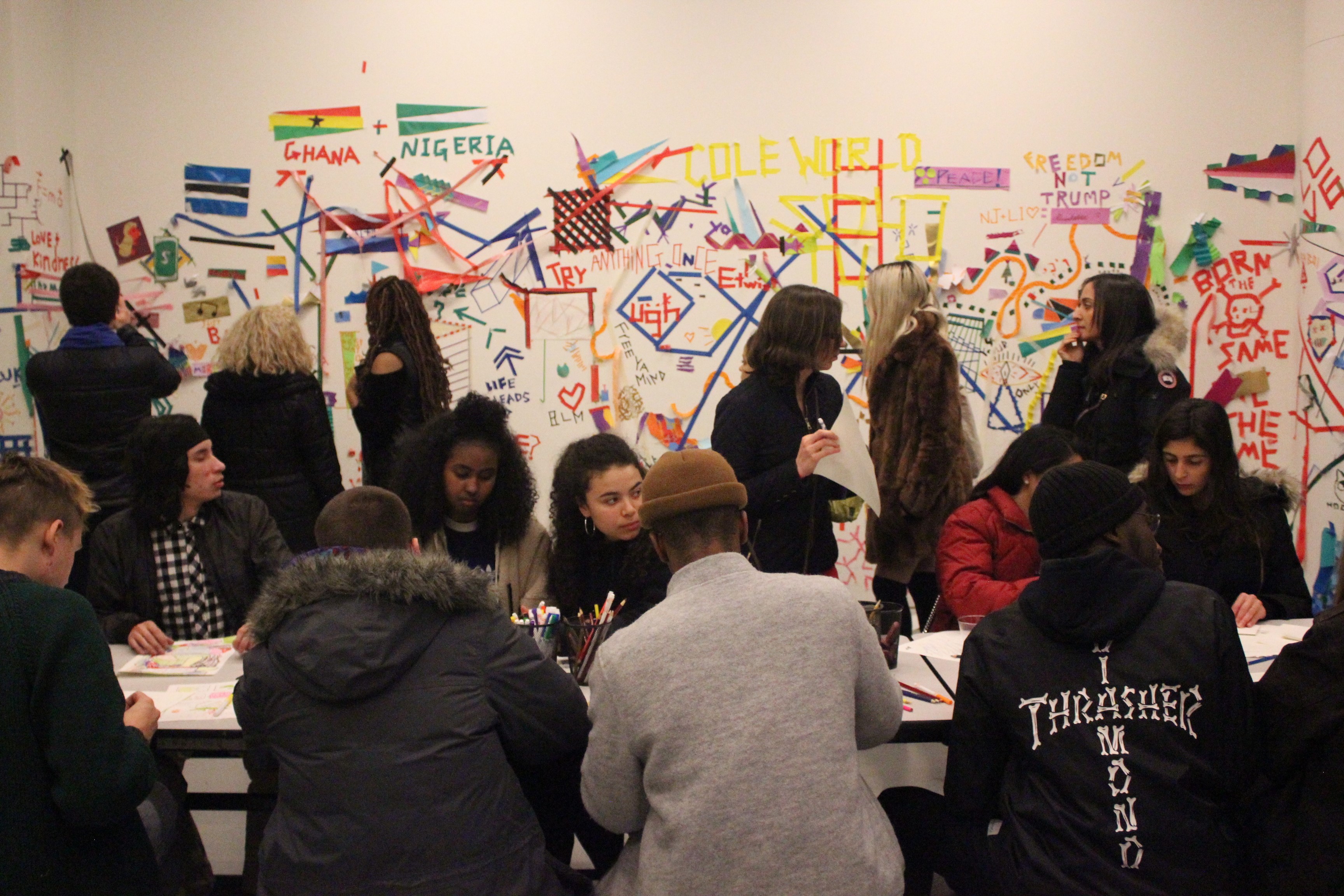
Visitors adding tape drawings to the walls in response to Jason Middlebrook’s mural, which spans the second floor walkway.
10:42 pm
I head for Beyond Limits / Political Intent, the show in the first floor galleries where an open mic co-hosted by Epicenter Community is scheduled around Amalia Pica’s Now, Speak!, a concrete podium where all are invited to make declarations. A group named ‘Rose Petals’ performs ‘Wade in the Water,’ some of them dancing, a broad-shouldered guy in a keffiyah accompanying on the saxophone. At the end of the song, one performs a spoken word piece that ends with a statement of solidarity with Standing Rock. From behind the podium, Andrea Bowers’s life-size portrait of CeCe McDonald, a trans rights activist incarcerated for self defense, keeps watch.
10:57pm
The second floor lounge is full of people breaking it down, with everyone too stodgy to sitting in booth tables towards the back. On a darkened wall hangs one of those very large paintings of the back of a painting. In the center of the canvas the twine crosses, for example, and that was the event of the narrative tension. Nobody was looking at it.
11:34
I head towards figure drawing, which has clothed models and drawing materials available until 1am. I accidentally meet some museum higher-ups who seem surprised by my comment that there are few opportunities for artists in Boston, then spend the next 25 minutes sketching the model and regretting not saying something else to the people at the helm of the MFA. (You know, about honoring guards’ requests to stop replacing their jobs with security cameras, or instituting a residency program for emerging artists like the one at the Museum of Fine Arts Houston).
12:02am
Overheard: “What is this?” “Someone braiding pencils into her hair.” “And what is the objective of that?” I guess I found the performance art.
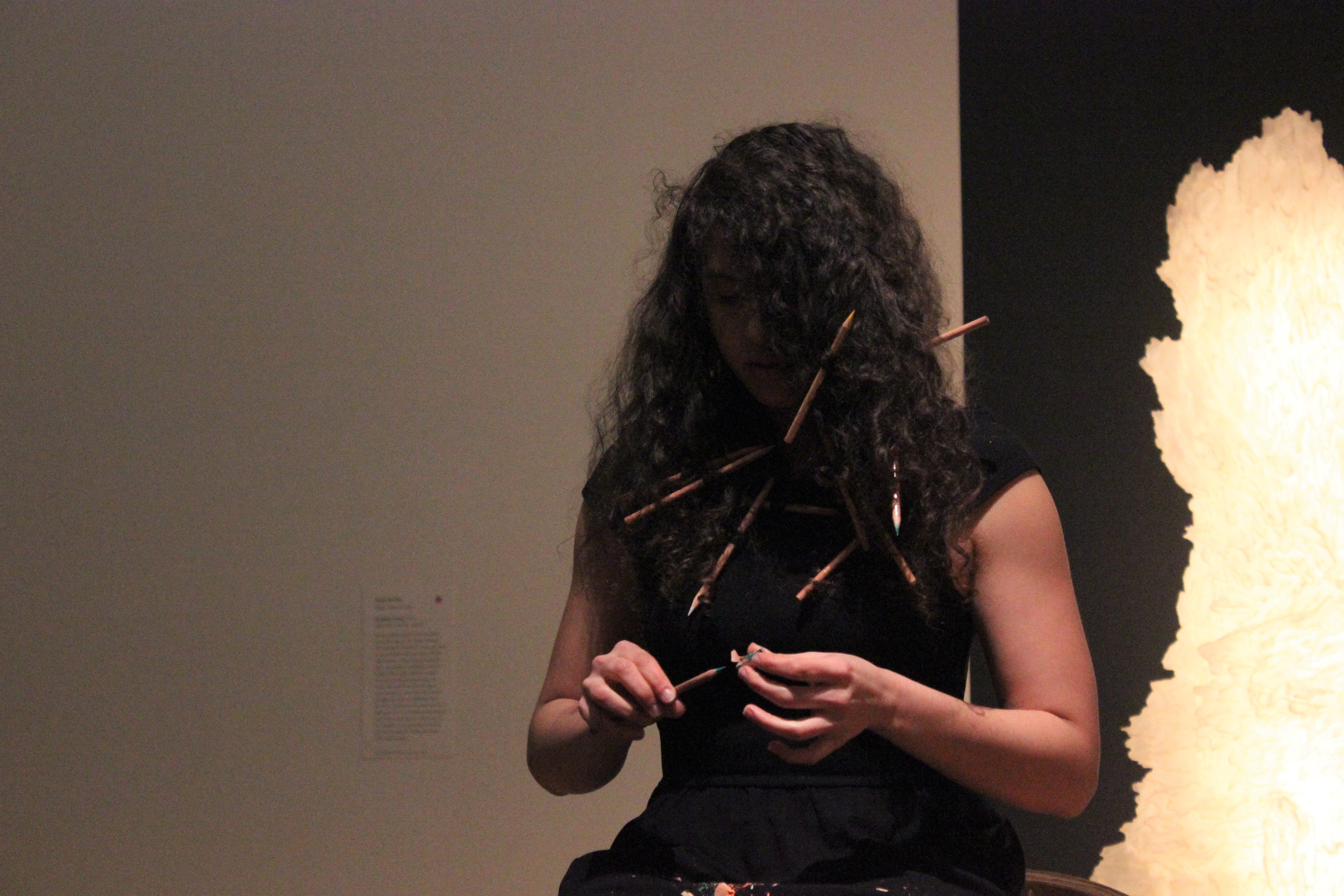
Alicia Rodriguez Alvisa, student at the School of the Museum of Fine Arts, braids pencils into her hair as part of the performance art program.
12:27am
Frances Stark round one. Part of the show, a well-lit room with grey sectional couches that look straight out of an early 2000’s Pottery Barn catalog, has been liberated from its art-viewing function and has been converted into a popular place to sit down and text for a while. This is amusing because the art object is in this case the very Internet vernacular that the would-be art viewers are now ignoring in lieu of their own texting.
12:43 am
Frances Stark just referencing herself now. Time for coffee!
2:37am
Coffee goal reached. Line at the ground floor café didn’t move for like half an hour while café staff changed out all the food in the display case. Lest I idealize the night as public programming too much: the people who clean the museum, and the people who guard the art objects, just look exhausted.
3:28AM
The line for The Clock is finally getting shorter. Maybe I can get in for the 3AM – 5AM bracket, when, according to the film’s Wikipedia entry, the characters tend to dream.
3:35AM
The line for The Clock is backed up, overlapping with the line to get into the second floor club, which is now packed for the last half hour it’s open. Sighting: White guy in a black waistcoat with a stenciled Chairman Mao face on the back. I’m too tired to think anything coherent about visual culture and the kneejerk leftism of art school kids.
4:03AM
I look up from my casual 4AM coffee among the other casual 4AM coffee-drinkers (the alcohol sales just ended) to the sounds of chanting. There’s a group of people putting on their coats, looking like they’re on their way to or from the club, the women in ringletted hair and black ankle boots, the men in button-down shirts. They’re all chanting three letters, and at first I think it’s U-S-A! U-S-A! U-S-A! (Ah, my Freudian hearing, all revved up as we sink deeper into a feverish nationalism). They’re gathering for a group photo and they’re so loud that everyone turns to look. Then I realize they’re chanting: M-F-A! M-F-A! M-F-A!
Why should this be odd? Why is it totally unheard of for people to have as much slap-happy faith in their museums as they do in their country or football team?
4:13AM
I wander past the coat check where the revelers had stood chanting and realize that behind them was Jeppe Hein’s Please…
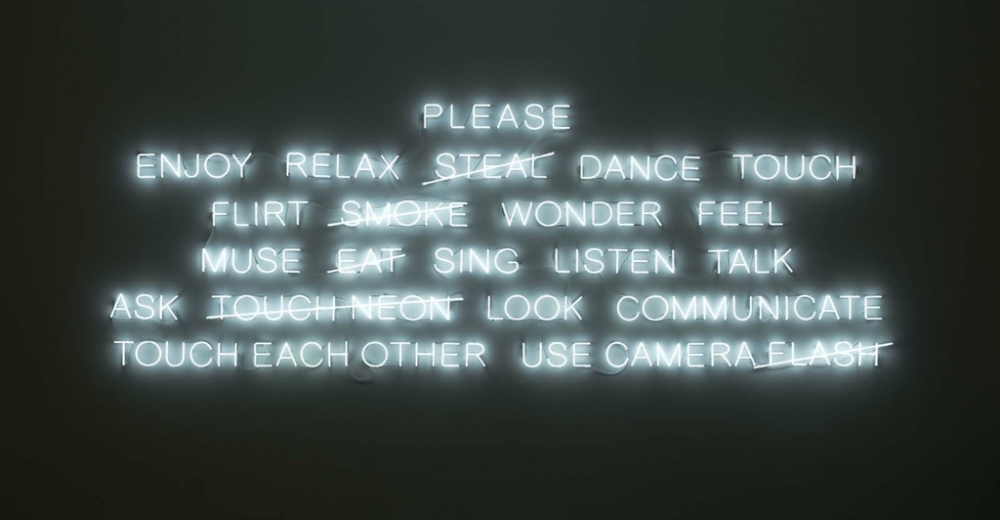
PLEASE…, Jeppe Hein, 2008, Photograph © Museum of Fine Arts.
5:39AM
It’s now or never for The Clock, which although most of the museum has thinned out still has a slow-moving line. Person behind me in line pulls out a tiny djembe and begins to sporadically drum and sing. Person in front of me, noticing the dates on the Frances Stark show banner on the opposite wall (‘UH-OH: Frances Stark 1991-2015’), wonders aloud if this artist died at fourteen. Bad math aside, I now prefer to read Frances Stark’s work as that of a precocious teen girl, cut low in the flower of her youth, but not before she had the good sense to transcribe and animate her digital tete-a-tetes with German randos.
6:12AM
“You should be getting in just around dawn,” says the woman pacing the line as I enter The Clock.
As soon as I enter a screening whose premise is the time pictured as it passes, I lose all sense of it. The following three hours are a haze of clock faces and half-sleep with a smattering of interruptions from my fellow viewers (sleeping person A’s phone goes off repeatedly, their seatmate leaps up with a dramatic sigh and returns with a guard, pointing a finger at the offending seatmates sprawled on the white Ikea couches: “He’s sleeping and her phone’s going off!”).
9:22AM
In the clip, she gets into her friend’s convertible carrying a box of cupcakes. How did you have time to make those, says her friend. There’s a beautiful twenty-four hours in the day, she says, winking, as they drive off. And with that, I head home.
